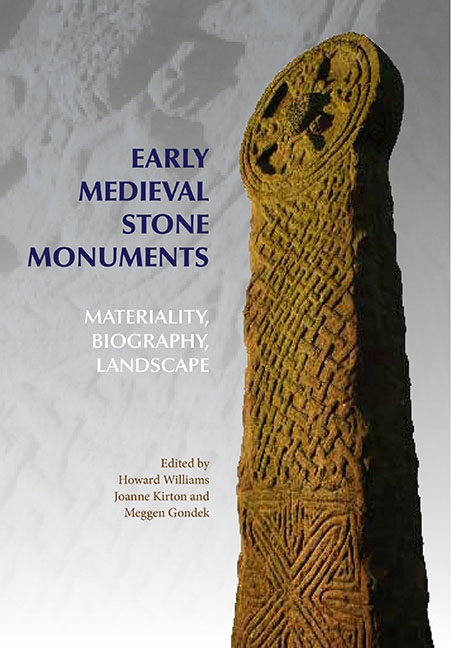Book contents
- Frontmatter
- Dedication
- Contents
- List of Illustrations
- List of Tables
- Acknowledgements
- 1 Introduction: Stones in Substance, Space and Time
- 2 Locating the Cleulow Cross: Materiality, Place and Landscape
- 3 Walking Down Memory Lane: Rune-Stones as Mnemonic Agents in the Landscapes of Late Viking-Age Scandinavia
- 4 Building Blocks: Structural Contexts and Carved Stones in Early Medieval Northern Britain
- 5 Memory, Belief and Identity: Remembering the Dead on Iniscealtra, Co. Clare
- 6 The Biographies and Audiences of Late Viking-Age and Medieval Stone Crosses and Cross-Decorated Stones in Western Norway
- 7 Lifeways in Stone: Memories and Matter-Reality in Early Medieval Sculpture from Scotland
- 8 A Stone in Time: Saving Lost Medieval Memories of Irish Stone Monuments
- 9 Hogbacks: the Materiality of Solid Spaces
- List of Contributors
- Index
9 - Hogbacks: the Materiality of Solid Spaces
Published online by Cambridge University Press: 21 May 2021
- Frontmatter
- Dedication
- Contents
- List of Illustrations
- List of Tables
- Acknowledgements
- 1 Introduction: Stones in Substance, Space and Time
- 2 Locating the Cleulow Cross: Materiality, Place and Landscape
- 3 Walking Down Memory Lane: Rune-Stones as Mnemonic Agents in the Landscapes of Late Viking-Age Scandinavia
- 4 Building Blocks: Structural Contexts and Carved Stones in Early Medieval Northern Britain
- 5 Memory, Belief and Identity: Remembering the Dead on Iniscealtra, Co. Clare
- 6 The Biographies and Audiences of Late Viking-Age and Medieval Stone Crosses and Cross-Decorated Stones in Western Norway
- 7 Lifeways in Stone: Memories and Matter-Reality in Early Medieval Sculpture from Scotland
- 8 A Stone in Time: Saving Lost Medieval Memories of Irish Stone Monuments
- 9 Hogbacks: the Materiality of Solid Spaces
- List of Contributors
- Index
Summary
INTRODUCTION
The hogbacks of northern England and southern Scotland have long been seen as a distinctive category of tenth- and early eleventhcentury early medieval stone monument resulting from Hiberno-Norse influence and settlement. This chapter reviews previous research and suggests a new foundation for their interpretation, arguing that hogbacks were an effective commemorative media because of the mnemonics of their materiality. Specifically, I focus upon the skeuomorphic allusions inherent in the ornamentation and form of hogbacks. Combined with their solidity and lithic weight, hogbacks cited a multi-scalar network of architectural material cultures and buildings already established within Britain and Ireland prior to, as well as during, the Viking Age. Rather than exclusive translations of secular halls into stone as often portrayed in both popular and scholarly research (e.g. Stocker 2000; Eriksen 2013), hogbacks cited a complex network of buildings (including secular halls but potentially also churches) and small-scale architectures (from biers and coffins to caskets and reliquaries) which were distilled into a solid lithic architectural form in various fashions. In this regard, hogbacks operated as elite commemorative monuments because their form connected to this shared elite network of architectural ‘things’ and implied the presence of the dead as inhabiting, or at least accessible through, the monument. Endbeasts and other themes of conflict were apotropaic in this context. The monstrous, sometimes ursine, beasts threaten to engulf some hogbacks – although sometimes they are demonstrably curtailed by their binding and muzzling. The emphasis upon bound beasts reveals the significance of sealing and fixing the tomb in place through its hogback design.
This approach aims to embrace, rather than obscure, the internal variability of the hogback tombs by focusing on their architectural materiality and lithic solidity as well as the hitherto close attention afforded to hogbacks’ form and ornamentation. Hence, hogback tombs were a commemorative strategy that installed and bound the dead in place within the church or churchyard by citing not a single source of influence but a range of other mythical and biblical as well as quotidian architectural spaces in which heroes, saints and other powerful figures were honoured and recalled. Hogbacks created a mnemonic network linking imagined pasts and projected aspired futures for the groups creating, installing and performing around them.
- Type
- Chapter
- Information
- Early Medieval Stone MonumentsMateriality, Biography, Landscape, pp. 241 - 268Publisher: Boydell & BrewerPrint publication year: 2015
- 2
- Cited by



